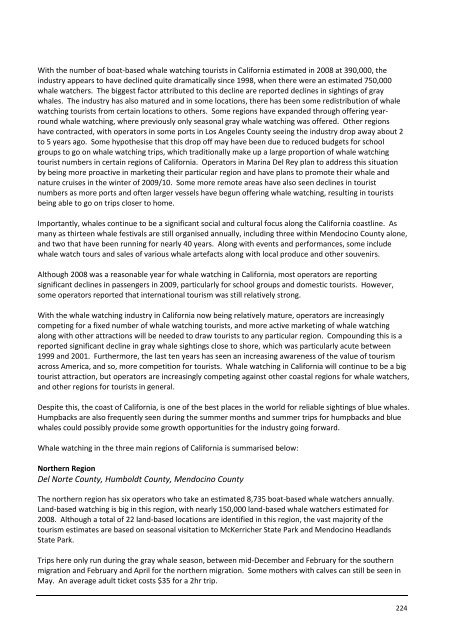Whale Watching Worldwide
Whale Watching Worldwide
Whale Watching Worldwide
You also want an ePaper? Increase the reach of your titles
YUMPU automatically turns print PDFs into web optimized ePapers that Google loves.
With the number of boat‐based whale watching tourists in California estimated in 2008 at 390,000, the<br />
industry appears to have declined quite dramatically since 1998, when there were an estimated 750,000<br />
whale watchers. The biggest factor attributed to this decline are reported declines in sightings of gray<br />
whales. The industry has also matured and in some locations, there has been some redistribution of whale<br />
watching tourists from certain locations to others. Some regions have expanded through offering year‐<br />
round whale watching, where previously only seasonal gray whale watching was offered. Other regions<br />
have contracted, with operators in some ports in Los Angeles County seeing the industry drop away about 2<br />
to 5 years ago. Some hypothesise that this drop off may have been due to reduced budgets for school<br />
groups to go on whale watching trips, which traditionally make up a large proportion of whale watching<br />
tourist numbers in certain regions of California. Operators in Marina Del Rey plan to address this situation<br />
by being more proactive in marketing their particular region and have plans to promote their whale and<br />
nature cruises in the winter of 2009/10. Some more remote areas have also seen declines in tourist<br />
numbers as more ports and often larger vessels have begun offering whale watching, resulting in tourists<br />
being able to go on trips closer to home.<br />
Importantly, whales continue to be a significant social and cultural focus along the California coastline. As<br />
many as thirteen whale festivals are still organised annually, including three within Mendocino County alone,<br />
and two that have been running for nearly 40 years. Along with events and performances, some include<br />
whale watch tours and sales of various whale artefacts along with local produce and other souvenirs.<br />
Although 2008 was a reasonable year for whale watching in California, most operators are reporting<br />
significant declines in passengers in 2009, particularly for school groups and domestic tourists. However,<br />
some operators reported that international tourism was still relatively strong.<br />
With the whale watching industry in California now being relatively mature, operators are increasingly<br />
competing for a fixed number of whale watching tourists, and more active marketing of whale watching<br />
along with other attractions will be needed to draw tourists to any particular region. Compounding this is a<br />
reported significant decline in gray whale sightings close to shore, which was particularly acute between<br />
1999 and 2001. Furthermore, the last ten years has seen an increasing awareness of the value of tourism<br />
across America, and so, more competition for tourists. <strong>Whale</strong> watching in California will continue to be a big<br />
tourist attraction, but operators are increasingly competing against other coastal regions for whale watchers,<br />
and other regions for tourists in general.<br />
Despite this, the coast of California, is one of the best places in the world for reliable sightings of blue whales.<br />
Humpbacks are also frequently seen during the summer months and summer trips for humpbacks and blue<br />
whales could possibly provide some growth opportunities for the industry going forward.<br />
<strong>Whale</strong> watching in the three main regions of California is summarised below:<br />
Northern Region<br />
Del Norte County, Humboldt County, Mendocino County<br />
The northern region has six operators who take an estimated 8,735 boat‐based whale watchers annually.<br />
Land‐based watching is big in this region, with nearly 150,000 land‐based whale watchers estimated for<br />
2008. Although a total of 22 land‐based locations are identified in this region, the vast majority of the<br />
tourism estimates are based on seasonal visitation to McKerricher State Park and Mendocino Headlands<br />
State Park.<br />
Trips here only run during the gray whale season, between mid‐December and February for the southern<br />
migration and February and April for the northern migration. Some mothers with calves can still be seen in<br />
May. An average adult ticket costs $35 for a 2hr trip.<br />
224

















